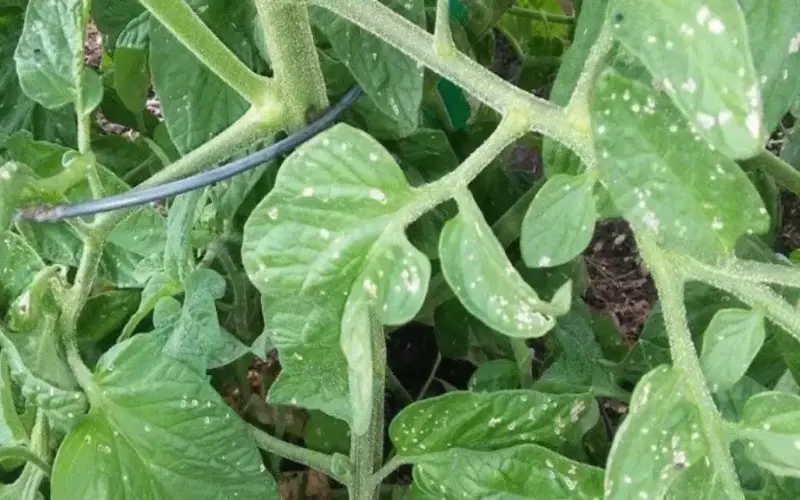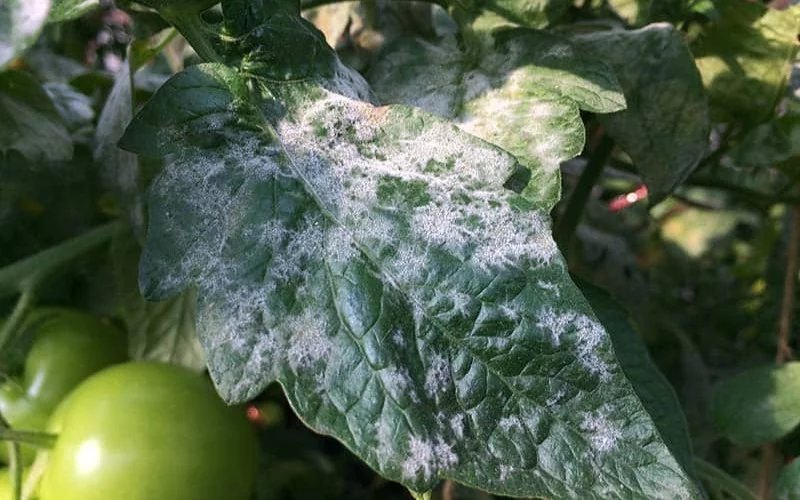Tomato is another staple plant that can be grown easily in your garden as it requires minimal care.
Tomatoes can be classified as a berry under the family of Solanaceae, and it takes about 60-100 days to grow this plant.
If you are starting to notice some white spots on your tomato leaves, you are probably wondering what causes them and how to get rid of these spots. We have explained all you need to know about these spots in this article and how to get rid of them.
What Are The White Spots On My Tomato Leaves?
When tomato leaves and white spots are associated together, then you are dealing with a case of powdery mildew. Powdery is a fungal disease affecting many plants, including tomatoes. A common identification of this fungal disease is the white or grey powdery spots present on the leaves.
These spots start from the bottom of the plants and then eventually spread towards the remaining leaves on the tomato plant. It can also affect the stems and be seen a little on the tomato itself.
What Causes White Spots On Tomato Leaves?

This condition can be caused by various species of fungi in the order Erysiphales. After this fungal attack, the powdery mildew spreads all over the plant if not controlled. This condition is facilitated in a warm and dry environment with fairly high humidity.
If powdery mildew is allowed to spread through your tomato leaves uncontrolled, it will cause the leaves to turn yellow and eventually cause severe harm to your tomato plant.
You may also notice stunted growth and weakness as part of the symptoms of powdery mildew taking over your plant.
How to Treat Powdery Mildew
Most products are manufactured to prevent powdery mildew; some homemade remedies can help eliminate this problem. To control this problem, you can use a solution of baking powder, milk, potassium bicarbonate, neem oil, or a fungicide.
1. Baking Powder Solution
For this method, you will need 1 tablespoon of baking soda, 1 gallon of water, and ½ teaspoon of liquid soap. Pour the water into a spray bottle and add all of these ingredients. Close the spray bottle and shake the mixture.
Spray this solution on the affected areas of your tomato leaves to get rid of the white spots. This method can also be used as a preventive measure against powdery mildew.
2. Milk
The chemicals contained in milk are very helpful in fighting a fungal disease like this on your tomato leaves. It can also be used to boost the overall immune system of your plant.
Mix about a half glass of milk into 2-3 parks of water and transfer this liquid into a spray bottle. Spray this mixture on the affected parts of the leaves, and spray behind the affected leaves as well.
3. Potassium Bicarbonate
Add 1 tablespoon of potassium bicarbonate and ½ teaspoon of liquid dish soap into a gallon of water. Shake this mixture well and transfer it to a spray bottle.
If not eliminated, spray this on the affected leaves and repeat after 3 days. This solution is considered better than the one made of baking soda as it also eliminates other plant diseases that may be developing.
4. Neem Oil
Neem oil is a go-to solution for treating various plant infections, and powdery mildew is no exception. All you need to of is apply some of this oil to the affected part of your tomato leaves.
5. Powdery Mildew Fungicide
The fungicide for treating powdery mildew usually contains sulfur, and this product can be used as a treatment and a preventive measure.
Aside from all these treatments, you can trim or prune the affected area. This can be done by removing the leaves with white spots to prevent them from spreading to the unaffected ones.
Preventive Measures for Powdery Mildew
If you have the mildest suspicion that your tomato plant has powdery mildew, or even if you want to be cautious, here are some preventive methods you can consider.
- Give a reasonable amount of space between each plant to prevent easy infection of plants.
- Remove the dead foliage in your tomato plant.
- Always disinfect your gardening equipment (pruners or shears) before using it next time.
- New growths are more prone to this infection, so do not grow many of them at once. This can be achieved by not over-fertilizing.
- You can grow species of tomatoes that are more resistant to powdery mildew.
- Organize regular treatment as a preventive measure by using an organic fungicide that is safer for your plant.
- Remove plants showing signs of powdery mildew.
You can also use the baking powder solution or neem oil as a periodic preventive measure, but use only a small quantity for this process.
How Does Powdery Mildew Spread?
These white spots on some of your tomato leaves can spread to others that are not yet infected. This can be done by the action of wind on the spores of the mildew.
This spread may not affect the leaves of plants resistant to this infection while other susceptible plants become affected.
Other plants susceptible to powdery mildew include sunflowers, roses, peppers, potatoes, parsley, pumpkins, grapes, zucchini, dahlias, melons, and others. If you happen to grow any of these plants, you should be very cautious of this infection.
Conclusion
The white spots you may notice on your tomato leaves are powdery mildew and caused by fungus. If you just noticed these white spots, do not panic, as they can be treated easily. You can consider using a solution of baking powder or potassium bicarbonate to get rid of the infection.
Other prevention and treatment methods include using a fungicide, neem oil, and the regular practice of trimming and pruning. We have listed some other preventive steps to take if you grow tomatoes or plants susceptible to powdery mildew.
Helpful Article:
- How To Properly Store Grass Seeds
- Best Bagged Soil For Vegetable Garden
- How To Propagate Monstera Adansonii
- How to Grow Brussel Sprouts in Containers
We trust this article helped you know what causes white spots on tomato leaves. You may also want to check out Do Deer Eat Tomatoes and Tomato Plants.
Thanks for taking the time to read our article, and we hope you find it helpful. Would you mind leaving a comment below if you have any suggestions?
Kindly reach out to people by sharing this post on social media.
If you liked this article, then please follow us on Facebook, Instagram, and Pinterest.

